
The valley is resplendent with Balsamroot – across Antelope Flats, up the eastern slopes of Shadow Mountain, along Wally’s World, and elsewhere. This abundant species is accompanied by an entourage of showy flowers worthy of note as well. Some are quite demure, and others puzzles to ID. But all signify spring moving quickly into summer in sunny Jackson Hole.
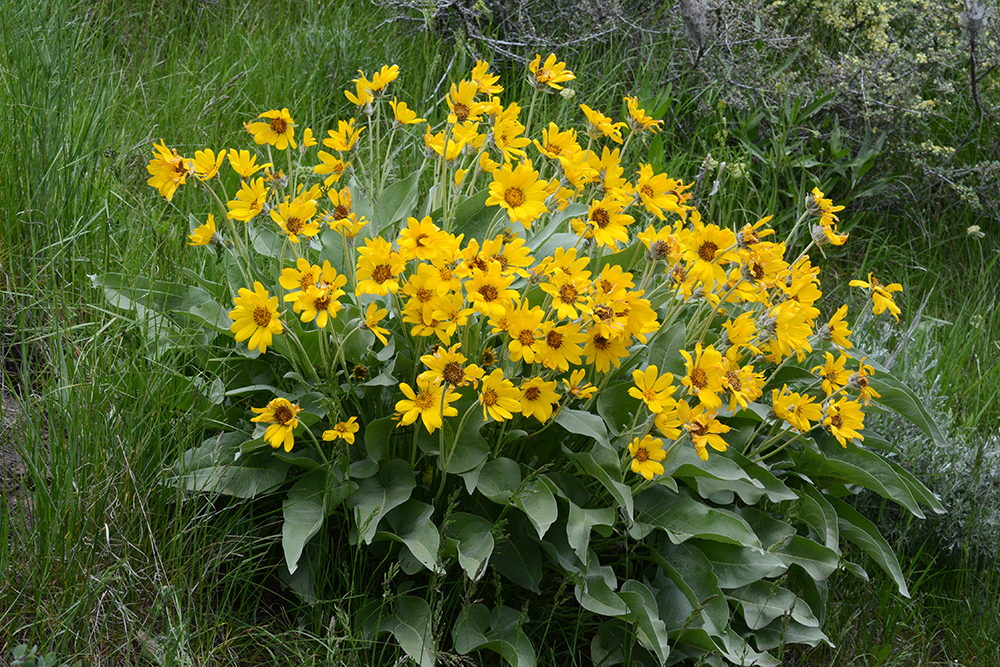
Arrowleaf-Balsamroot – Balsamorhiza sagittata- is a classic “composite” flower. The flower heads include many small individual flowers standing on a platform, all surrounded by protective bracts. Most are small disc flowers disc flowers that bloom from the outside in. The outer ray flowers help to attract and also serve as landing platforms for myriad pollinators.
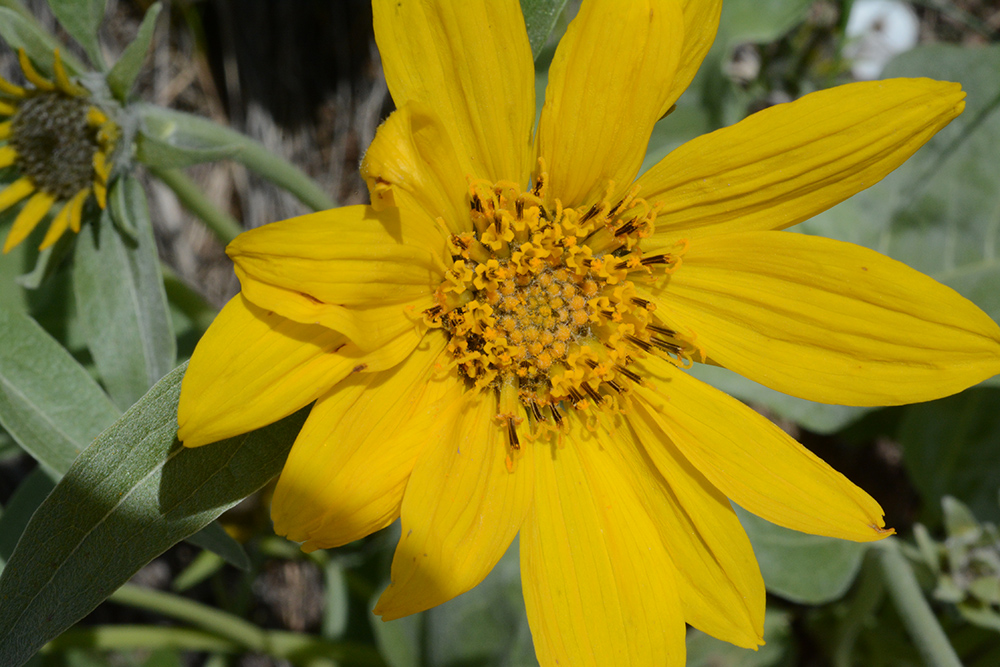
Each yellow disc flower performs “push pollination”. Inside the tube of 5 fused yellow petals, 5 dark anthers face inward forming a tight circle. The closed 2-parted yellow stigma extends up through this column, pushing pollen released by the anthers up and out for pollinators of bees and such to come and get it. Later the stigma of the flower opens wide to capture pollen from a different flower to prevent self-fertilization. However, if for some reason a pollinator does not deliver pollen, the curled-back stigmas can reach for its own pollen. Each of these flowers will each make a single fruit, as does our commercial sunflower. In Arrow-leaf Balsamroot, large, arrow-shaped leaves are all basal and grayish hairy. Also only one flower is held up on each stalk.

As Arrow-leaf Balsamroots fade, Mule’s Ears – Wyethia amplexicaulis – comes into their own. Several bright orange-yellow flower heads bloom on the stems. Dark green, smooth, mule-ear shaped leaves alternate up the stems. These plants grow in more water retentive soils. They dominate Wally’s World ridge and also low sites around the valley such as near the Oxbow in the park.

Other yellow composites:
Sahkalen Arnica – Arnica sororia – As in most all arnicas, leaves are opposite, each yellow head of both ray and disc flowers is surrounded by an even row of bracts. Usually single flower heads are held above 2-4 sets of opposite, sessile, ovate leaves on each stem, with more leaves with 3 veins at base. Details include white, slightly bristly hairs around the base of each disc flower. Overall plants are sticky hairy.

These arnicas are particularly plentiful out the northern end of Flat Creek Road in the Elk Refuge and scattered out Gros Ventre Road on the way to Kelly.
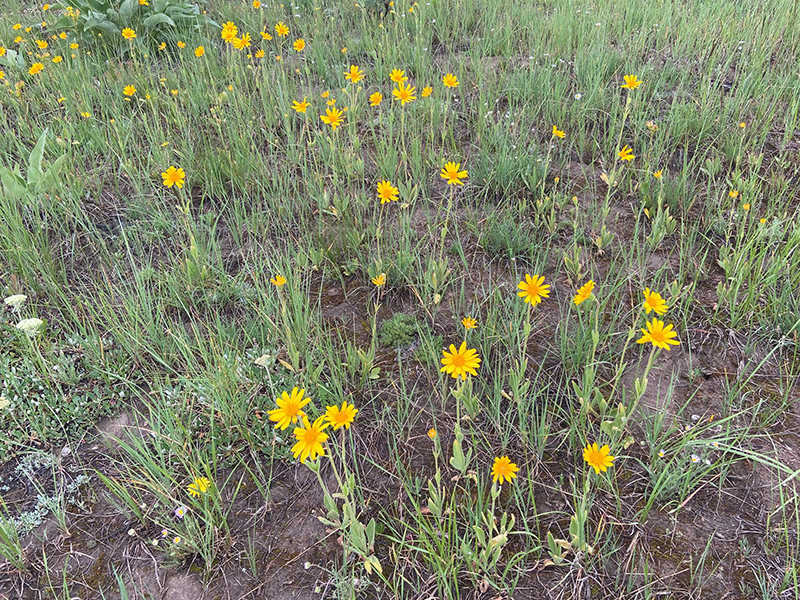
Western Groundsel – Senecio integerrimus – A common sagebrush habitat species, this groundsel stands about 12-18” tall. Most leaves are at the base, but some oblong leaves alternate up the stem.
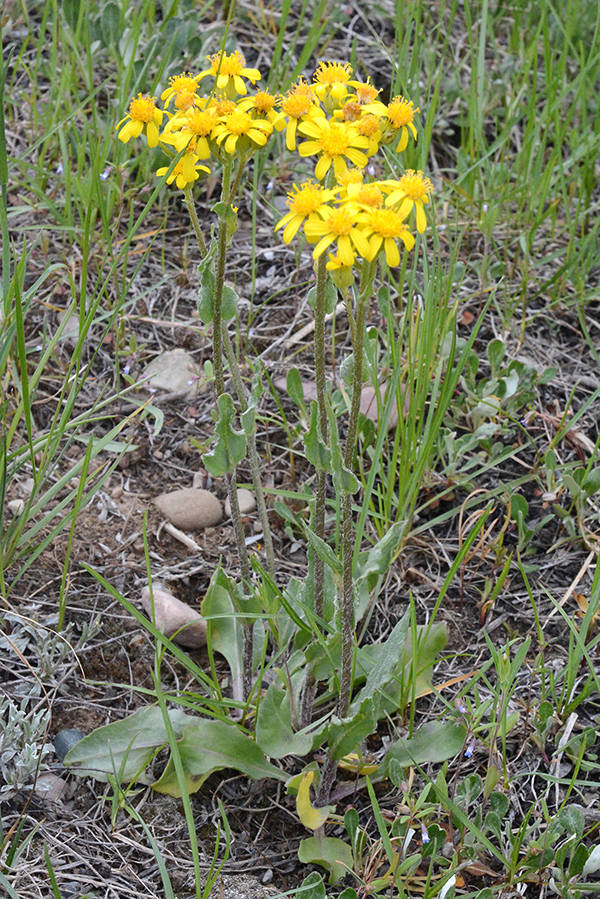
Note the fine cobwebby hairs on stem and leaves. Flower heads have bracts that are smooth, equal length, and tipped in black. They surround a few outer ray flowers and several more disc flowers in the center. I have been seeing a caterpillar eating these plants. (Anyone know what species it is?)

Stemless Goldenweed – Stenotus acaulis – In dry rocky roadsides and hill tops, one finds extensive mats of 3-4”, upright spear-shaped leaves are overtopped by numerous yellow flower heads.

Heads include several yellow, oblong, blunt ray flowers surrounding several disc flowers. Heads are protected by 3-4 rows of pointed, hairy bracts. This species tends to grow best on drier knolls within sagebrush or grassland habitat.
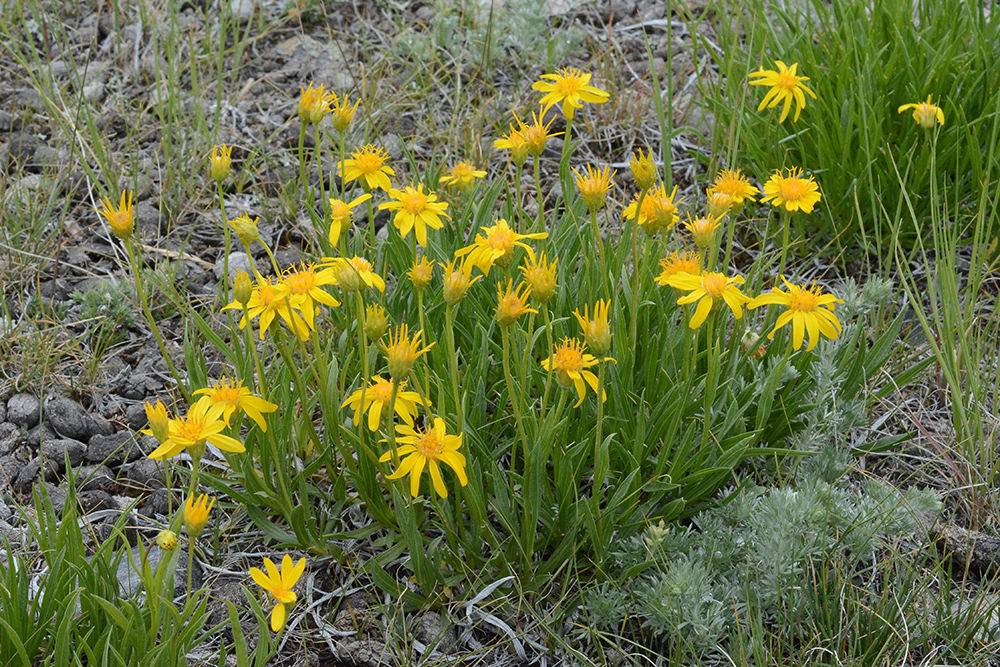
Also mixed in are two other 6-8” species that look very similar at first. A puzzle for botany nerds. Both have tap roots, heads with all yellow ray flowers surrounded by somewhat broad bracts arranged in 2-3 alternating rows. Leaves are long and narrow. From there to details:
Microseris – Microseris nutans – often has several stems with several flowers arising from the base. Note that some stems and leaves alternate up the stem. Also, flower buds nod…hence “nutans”.

Narrow leaves have smooth to slightly toothed edges. Even finer details: the outer bracts are few and short, the inner two rings have longer, broader bracts that taper to a point.

The shiny white pappus of each fruit is “plumose” with broad scaly bases.

Nothocalais – Nothocalais troxmoides – is very similar (they used to be in the same genus Microseris). Compare closely: Typically Nothocalais has only a single flower stem surrounded by thin, slightly wavy, all-basal leaves.
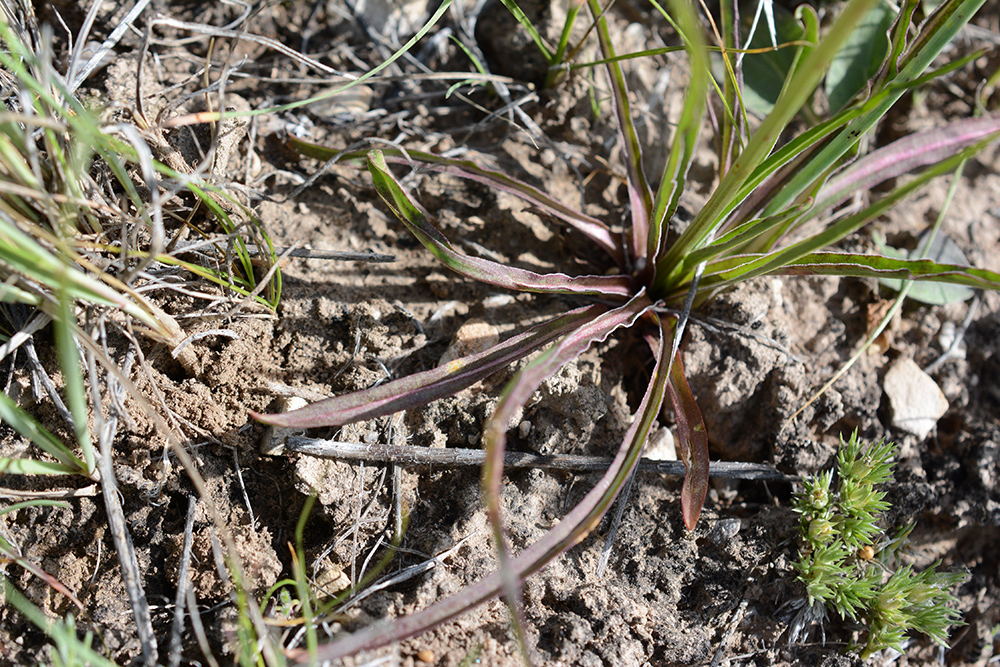

The bracts are all about the same length, often finely dotted with purple. Each fruit has bristles that broaden only slightly at the base.

Confusing yellow composites to come:
False Dandelions – Agoseris glauca varieties – tend to be larger than the above, leaves are all basal, some with fine teeth, flower heads of all yellow ray flowers borne on single stalks. Bracts and leaf shape determine which subspecies.
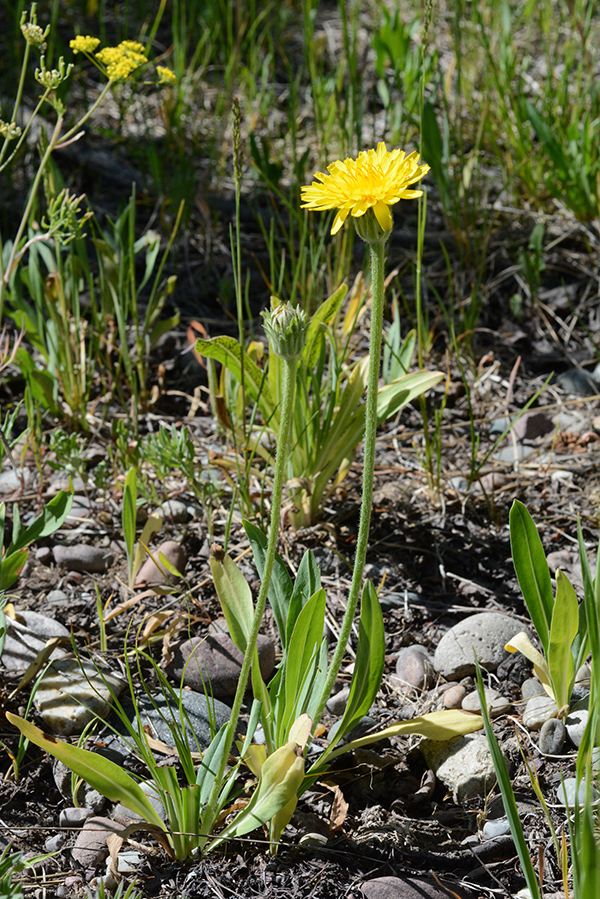
Hawksbeards – Crepis spp. – Many all-ray flower heads held up on several branching stems.

Leaves variable, often with large sharp teeth, arranged both at base and alternating up stems.
White composites:
We have many Fleabanes or Fleabane Daisies – Erigeron spp. – in Teton County growing from a few inches to a few feet high. They can be difficult to key to species. All Fleabanes have equal-length bracts surrounding usually many thin ray flowers that in turn encircle tiny yellow disc flowers, like a typical “daisy”. The white (vs blue) species are the more complex to ID, I find.

Shaggy or Low Fleabane – Erigeron pumilus – form dense bunches of hairy (sticking out like a fraidy-cat hair) stems and leaves about 4-5” high. Commonly found in drier soils of sagebrush and dry knolls.
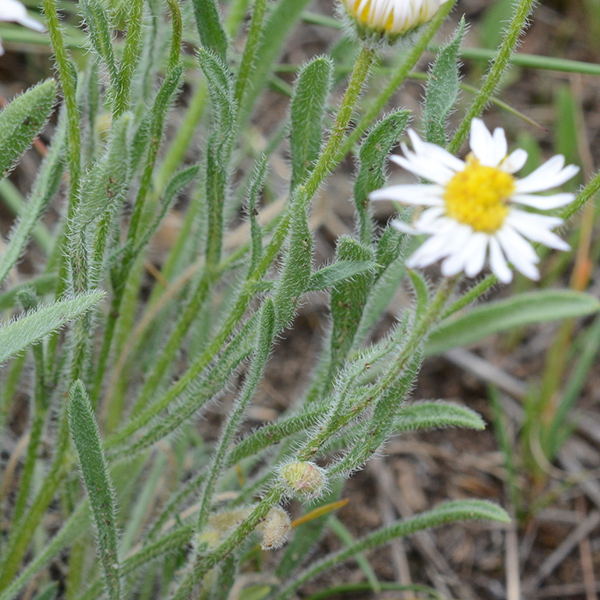
Another very similar low species is easier to ID: – Cutleaf Daisy – Erigeron compositus. Also, low growing with white composite heads in similar dry habitats, this species has divided leaves. It is going to seed now.

Rarely seen in Jackson Hole but abundant up at Island park, ID, in moist meadow areas are White Wyethia – Wyethia helianthoides.
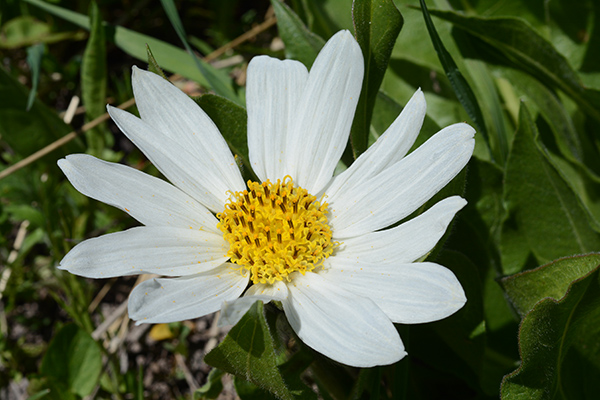
Hard to miss or mistake!

A mix of colorful species:
Stoneseed/Puccoon – Lithospermum ruderale – are robust plants with 1-2’ tall straight stems. Narrow leaves are 1-2” long, alternating up the stem.
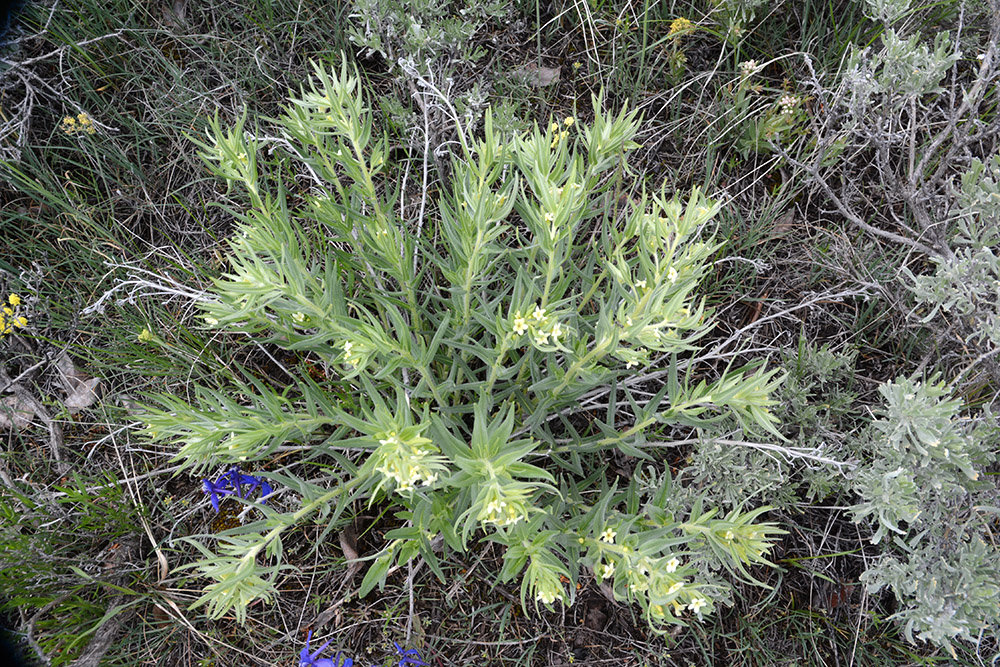
Pale-yellow tubular flowers are clustered and tucked into the axils of the upper leaves. Flowers have a lovely fragrance.

Later they will form very hard white fruits each with one seed – hence its name Stoneseed. Borage Family

Sulphur Buckwheat – Eriogonum umbellatum – is just unfurling its flat-topped clusters of creamy yellow to pinkish flowers.

Note the collar of oval leaves below the inflorescence and the many mat-forming leaves at the base. Buckwheat Family/Polygonaceae

Prairie Smoke – Geum triflorum – Usually 3 (-5) pinkish rose-colored flowers dangle about 6-12” above the finely pinnately divided leaves which cluster at the base.

The 5 sepals are rose colored, with 5 yellow petals barely peering out.
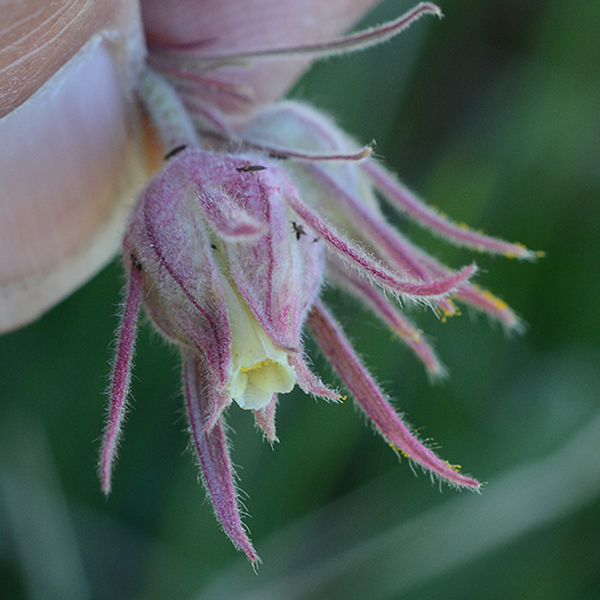
Later the many separate pistils mature into individual fruits with unfurling fine long hairy stigmas that give the plant is Prairie Smoke name. Rose Family.

Long-leaved Phlox – Phlox longifolia – forms pinkish, bluish to white patches along roadsides, sageflats, and other sunny spots.
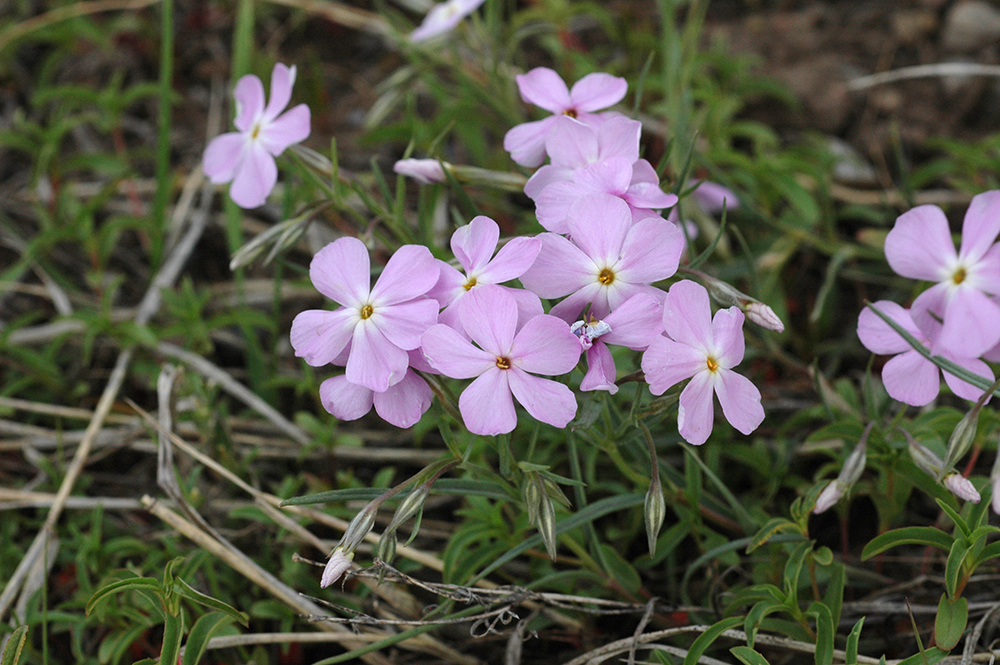
This plant stretches its 6-12” stems to display its flowers. The fragrance is wonderful and attracts long-tongued insects that can perch on the flaring petals and reach down into the long tube for nectar. Phlox Family/Polemoniaceae
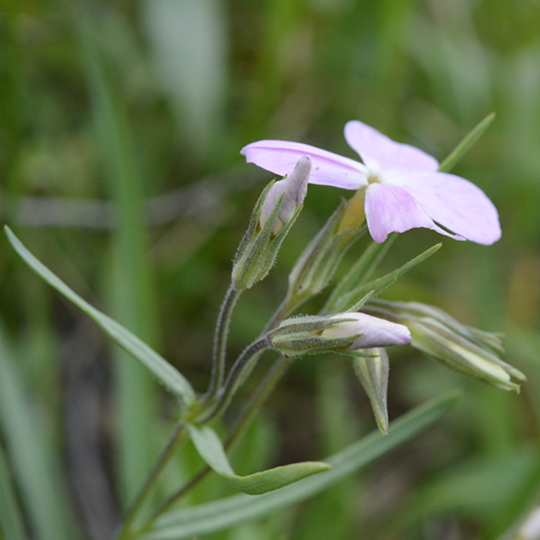
Stonecrop – Sedum lanceolata – clusters of 2-3” stems with pudgy ¼- ½ ” succulent leaves grow on rocky sites. The sepals are deep orange but the 5-petaled flowers are yellow when fully opened.
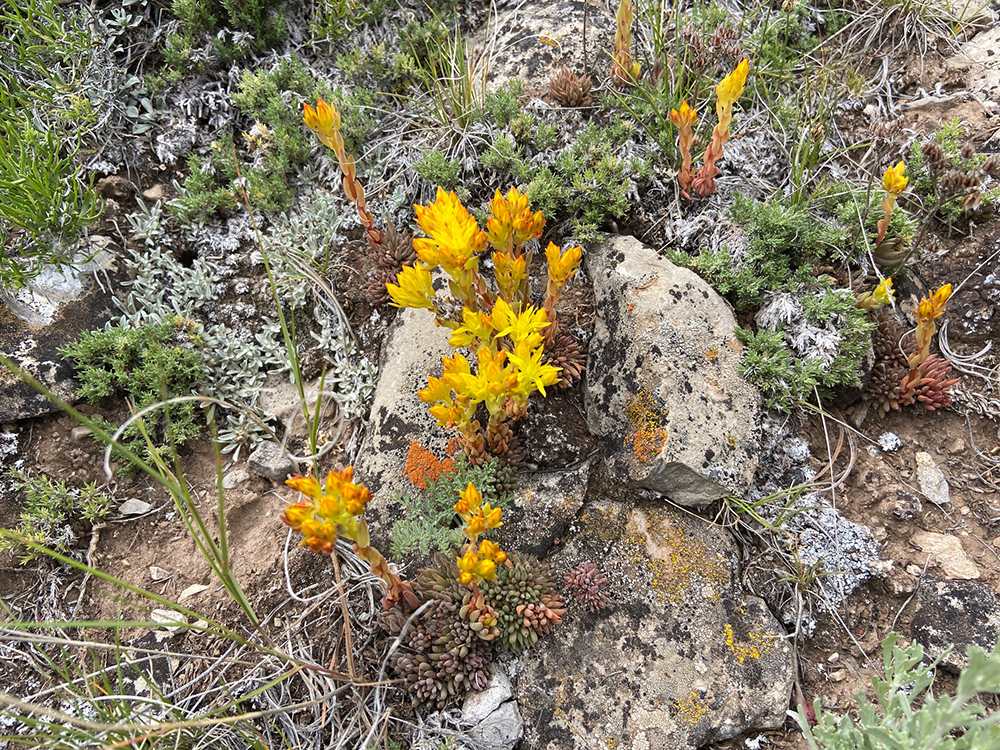
Yellow Paintbrush – Castilleja flava var. flava– is frequent on sageflats right now. Growing up to 18”+ tall, it presents yellow flowers held out above the axils of greenish-yellow divided bracts.

The yellow-green calyx is narrow with two short-pointed side lobes and longer slits back and front. The mature corolla of 4 fused petals extends beyond the calyx of sepals, often leaning out. The galea is clearly longer than the lip.The anthers are tucked inside and the stigma will extend out a bit. Leaves are divided into sparse thin lobes.

As with many of our paintbrushes, this species is a hemiparasite. Its known host plant is not surprisingly sagebrush – Artemisia.
And still flowering strong, are Desert Paintbrushes – Castilleja chormosa – in a class of its own for its brilliant, glowing,scarlet color of it bracts and sepals. Its hard to pick the best picture!
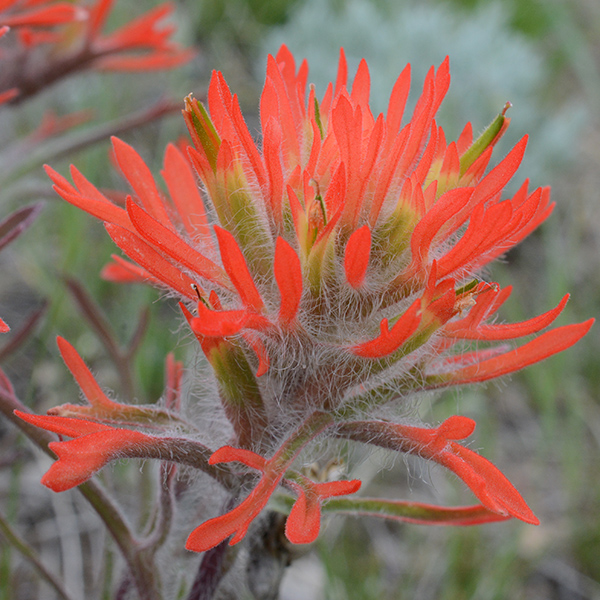
In the first fall, the dissected leaves of Scarlet Gilia – Ipomopis aggregata – form frilly looking, unimpressive rosettes for the first winter.

Come spring stems sprout up to 3-4 feet by end of June and flower. Most plants then die, essentially being biennials.
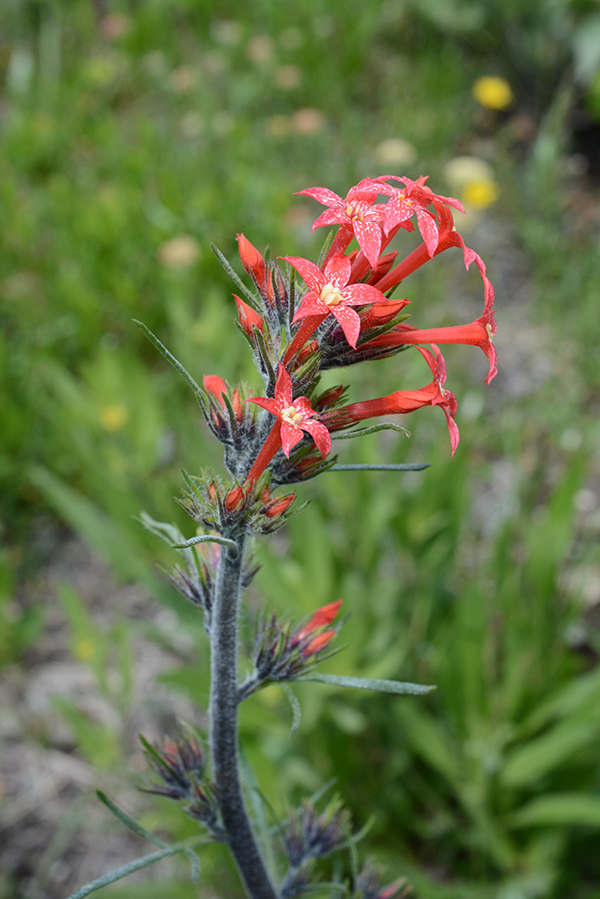
The seeds will produce, with luck, the next cohort of Scarlet Gilias to greet the next year’s hummingbirds and moths.
Blues:
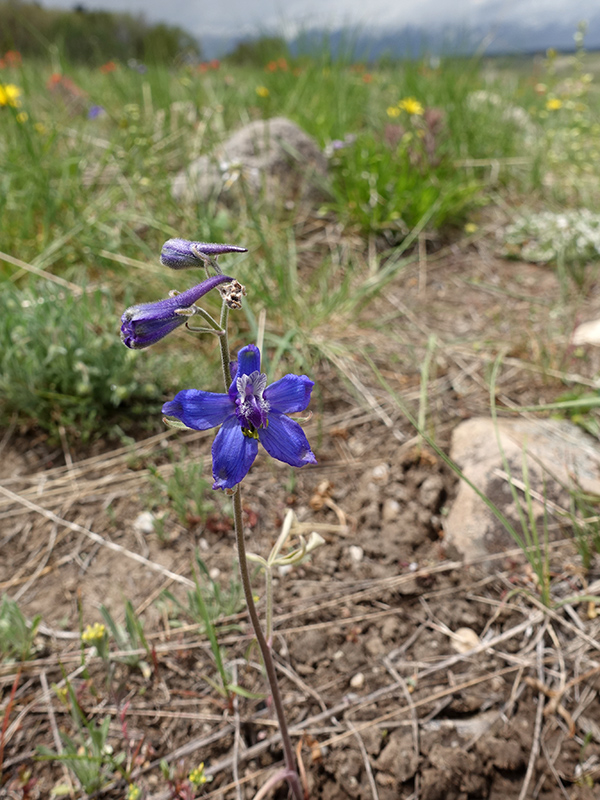
Nuttall’s Larkspur – Delphinium nuttallii – is an early-spring larkspur of only about 6-8” high. The leaves are palmately divided, reminiscent to a bird’s foot. The flowers are deep blue. Delphinium flowers are intriguing.

Take a close look, and if not in the national park, maybe pick one flower and with all due respect dissect it with some friends as a learning opportunity. Observe the outer flaring 5 colorful sepals. The uppermost one forms a spur out the back. Of the 4 petals, 2 whitish ones with nectar lines stand upright, firm, and extend tubes back into the spur, holding nectar; the two blue petals with whitish hairs droop below and provide a landing pad for pollinators. They also cover the cluster of anthers.

Hidden within the anthers are three stigmas that will mature after the anthers have released their pollen to prevent self-fertilization. Nectar held in the two spurs encourages long-beaked birds – hummingbirds – or long-tongued insects to reach deep inside going back and forth between the two tubes, thereby hitting their heads or body on the dangling anthers or later upon the stigmas. Nuttall’s Larkspur differs from Low Larkspur – D. bicolor (photo below) – having all similar-sized sepals and the slits (notches) in the two lower petals are >1/4 of their length. I have seen these up in Yellowstone. Buttercup Family/Ranunculaceae
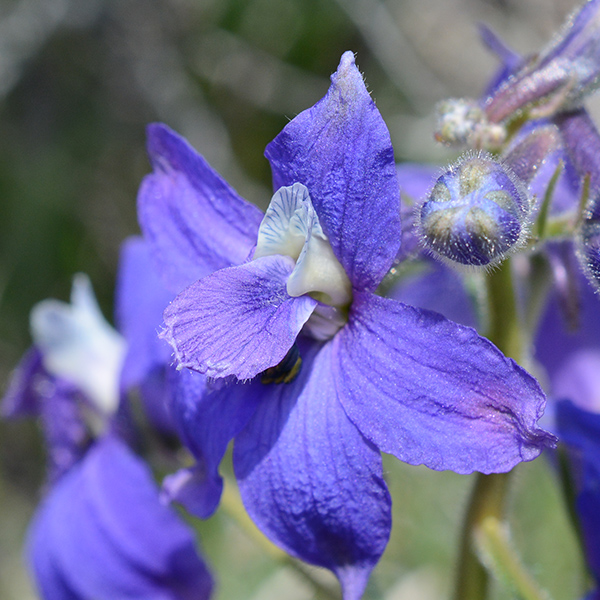
Two Lupines – Lupinus spp.
A couple of weeks ago, large 1-2’ blue lupines amassed along cobbly river basins such as seen from the highway while crossing Gros Ventre River or Spread Creek, and from the park road by Jenny Lake and into Lupine Meadows.

Large-leaf Lupine – Lupinus polyphyllus – has many palmately divided leaves and flower stalks with wide-open blue pea-like flowers. The back of the “banner” is more or less smooth.

Just emerging in sageflats are Silky Lupines – Lupinus sericeus. These differ in having

many silvery hairy leaves, forming slightly smaller flowers with obvious silky hairs on the back of the upright petal or banner.

All lupines are poisonous with alkaloids that are more concentrated in early growth or in seeds. Being legumes, lupines also can fix their own nitrogen. Some Paintbrushes – Castilleja spp. – actually attach to lupines underground and draw off alkaloids to reduce herbivory.
Mat-root Beardtongue – Penstemon radicosus – is in small1-1.5’-tall patches. All Penstemons have opposite leaves and tubular flowers with 4 anthers curled up inside and one tongue-like staminode—a sterile, often hairy stamen–that lies on the floor of the flower.
We have many penstemons, this one keys out to Mat-root Beardtongue because of the glandular hairs on sepals and petals (and all over the plant), the sepals that narrow to a point, and 1 mm smooth anthers arranged end to end inside.


There is no cluster of leaves at the base of the 18” stems.
Low Penstemon – P. humilis – is technically a very similar species: It has even smaller anthers .5-.8 mm and clusters of elongate leaves at the base.
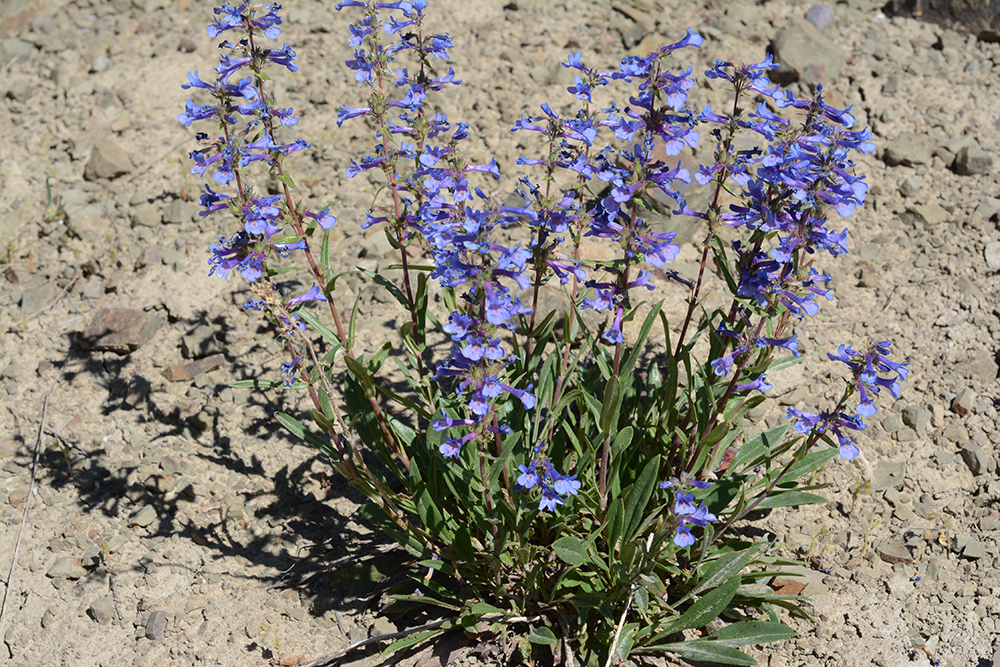
Some botanists can recognize the gestalt of each species. I still have to key them out–more fun than crossword puzzles or wordle!.
These species, like many penstemons, are pollinated by bumblebees. Snapdragon/ Scropulariaceae now in the Plantain Family/ Plantaginaceae
Sticky Geranium – Geranium viscossissimum – is opening its 5 pink to blue petals, attracting a range of pollinators who can land easily and follow the nectar guides to the center of the flower. Male anthers shed pollen first, then they dry up and a few days later the 5 pinkish stigmas expand ready to catch pollen brought from another flower.

Leaves are palmately divided into sharp-tooted leaflets.
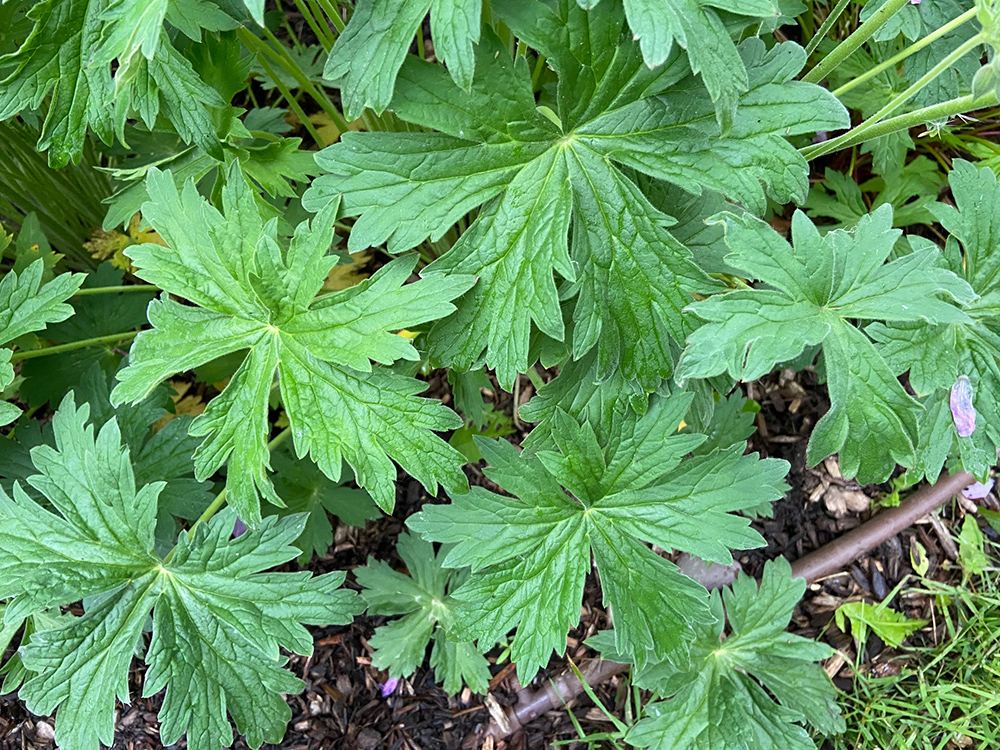
Glandular hairs make the stems sticky. These hairs trap tiny insects, from which plants obtain nutrients! Geranium Family/Geranicaceae
Lewis’ Flax – Linum lewisii – is common along hillsides and roads right now. Its sky-blue saucer- shaped flowers wave atop 2′, slender stems arrayed with narrow leaves.

Long, strong fibers have made this species and particularly its European cousin Common Flax – Linum usitatissimum – truly very useful for making cordage, linen, canvas, etc. The oil linseed oil, and flax seeds are used as a dietary supplement. Linoleum also comes from flax. Lewis’ Flax is named after Merriweather Lewis of the Lewis and Clark Expedition. The historical herbarium specimen is dated July 7, 1806, Montana. Flax Family/Linaceae
Whites:

Meadow Death Camus – Toxicoscordion/Zigadenus venenosus – is indeed poisonous. Plants contain a neurotoxic steroidal alkaloid called zygacine. Dried plants remain toxic for at least 20 years. (USFS) Look for 6-12”-long, narrow basal leaves and a taller raceme of many white, slightly yellowish (from nectar glands) flowers.
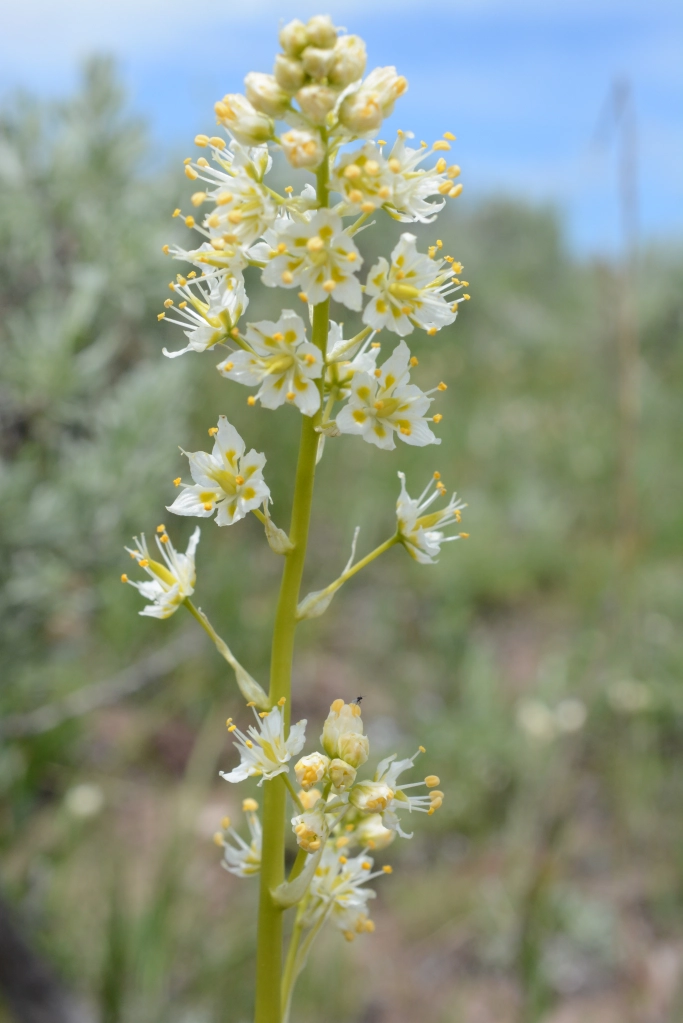
The plants grow up from storage bulbs. Formerly Lily, now Bunchflower Family/Melanthaceae

Often seen among pussytoes or fleabanes, Bastard Toadflax – Comandra umbellata – grows to 4-6”. Plants have alternating bluish green, smooth, lanceolate, 2” leaves. The pinkish buds open into white flowers clustered at the tops; each flower has 5 sepals (no petals) with 5 anthers, and one inferior ovary what will produce a hard urn-shaped drupe.

This native plant serves as an alternate host of the Comandra Blister Rust which infects lodgepole pines in our area. (It is not the same as the introduced white pine blister rust that plagues 5-needled white pines such as whitebark pines.) Bastard Toadflax also is a hemiparasite which draws nutrients from a variety of species including pussytoes, asters, wild strawberries, sedges, aspens, and roses to name a few.
The taxonomists are mixed on which family it belongs to. Dorn places it in the Sandlewood Family, and currently Rocky Mountain Herbarium has added in the fully parasitic Lodgepole Pine Dwarf Mistletoe – Arceuthobium americanum.

Others have put Bastard Toadflax in yet its own family Comandraceae. In any case it is an odd-ball genus has few close relatives in North America, despite its broad range across the continent into Europe.

Congested Sandwort – Eregomone/Arenaria congesta – holds up bunches of several white flowers, each with 5 petals, 10 anthers, 3 styles, all atop of wiry 5-6” stems with opposite narrow leaves. Just beginning to bloom. Pink Family/Caryophyllaceae.

Evening Primroses – Oenothera caespitosa – have huge white flowers that fade to pink and fold up by midday. The fragrance is wonderful, worth getting down on hands and knees. They depend on hawkmoths for pollination. Evening Primroses grow only here and there on usually very dry slopes. It is a bonanza to find this plant. Evening Primrose Family/Onagraceae.
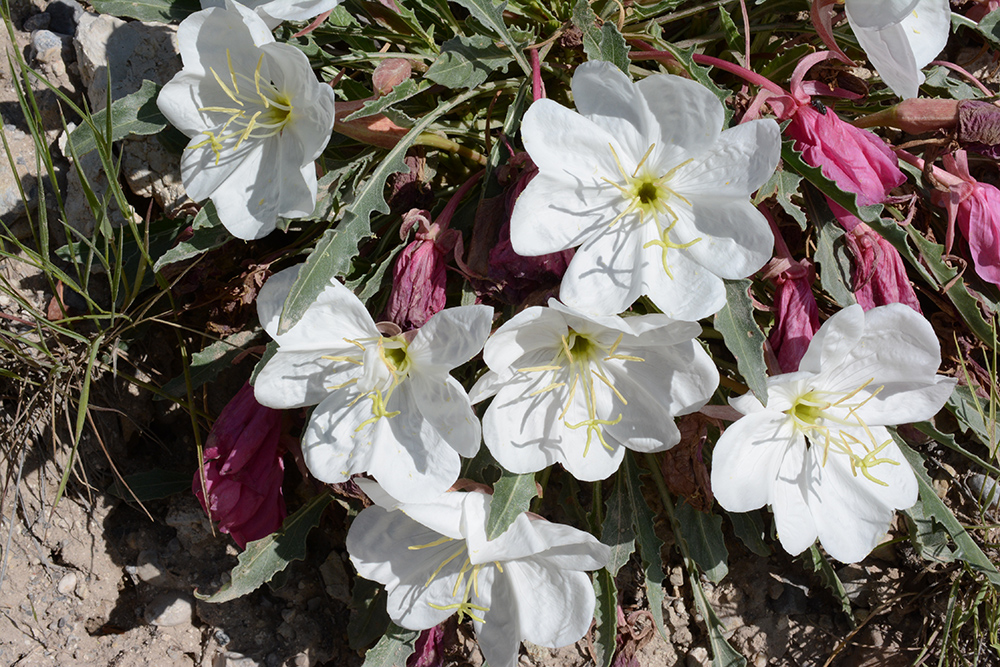
The flowers will keep coming in a variety of combinations to enjoy. The north end of Flat Creek Road, Antelope Flats, the Park Road, Wally’s World, Cache Creek trails are all places to see an abundance of favorites.
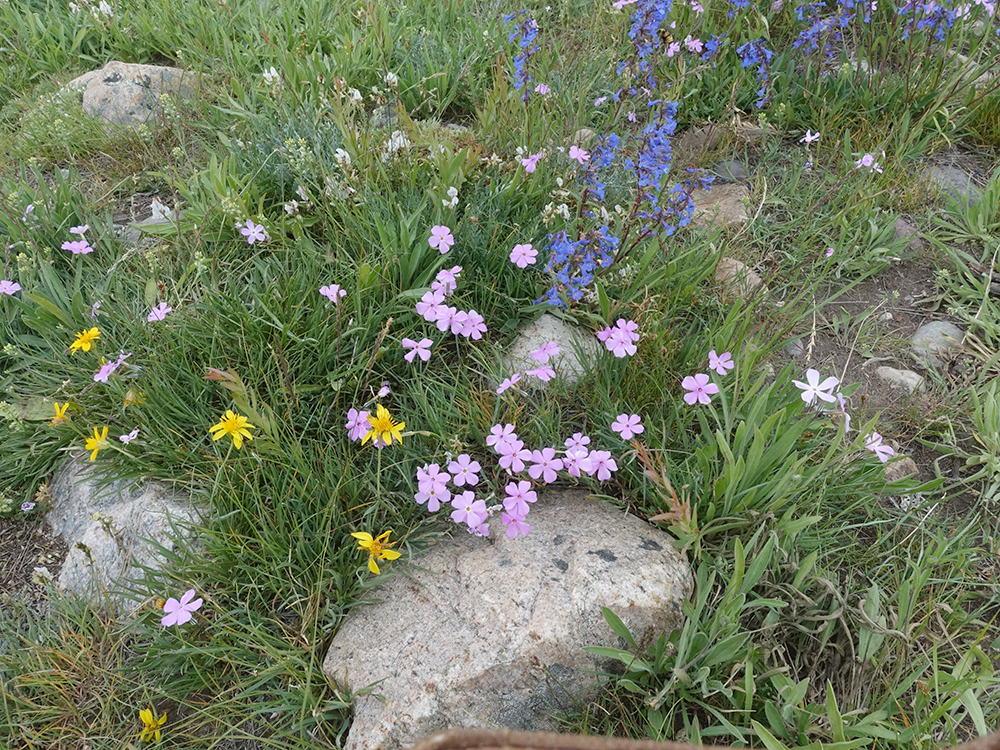
Frances Clark, June 19, 2023
As always we appreciate corrections and comments.
